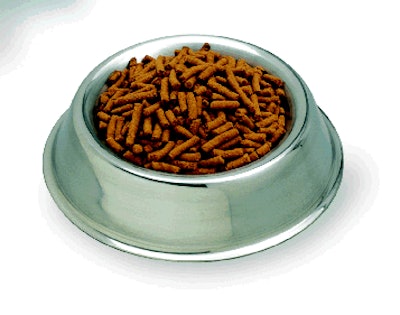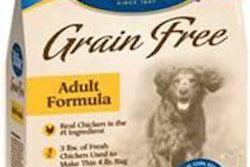
Talk about being ahead of your time. Bil-Jac Foods has made frozen dog food since 1947. And, since the mid-1980s, the company Bill and Jack Kelly founded has made dry petfoods with a unique processing system. A system that does not use extrusion. "It costs substantially more than typical dry petfood processing systems," says Bil-Jac president Bob Kelly, "but it is crucial to Bil-Jac's success; it is really more of an art than a process."
What is unique?
"No one comes close to making petfood the way we do," contends Kelly. How is Bil-Jac's processing unique? Let us count the ways:
1. Fresh chicken. Bil-Jac works closely with name-brand chicken processors and has control of the chicken from the time it is processed. The chicken ingredients are chilled immediately to maintain quality, and within hours they are in a bag of Bil-Jac petfood. Most petfood companies rely on rendered chicken meals, processed at 280-300°F, for their primary protein source.
2. Low-temperature, vacuum processing. Bil-Jac products are first pasteurized at about 200°F to destroy harmful bacteria. Then, vacuum processing brings the boiling point of water down to 165°F (versus 212°F at normal atmospheric conditions). During processing at these lower temperatures, the amino acids in the protein are not overheated. The result: Protein denaturization is greatly decreased. Notes Kelly, "Bil-Jac is essentially a raw food that has been pasteurized and carefully dehydrated."
3. Starches cooked separately. Bil-Jac starches undergo a separate, slow-cooking process to make the carbohydrates more digestiblearound 99%. "Most petfoods have carbohydrate digestibilities in the 75-90% range," says Kelly. "Sometimes people think their pet is allergic to certain grains, but what they may actually be reacting to is the way the grain is processed."
4. No added fat. The typical rendering process melts off much of the fat. The majority of petfood manufacturers then spray this rendered fat back on the extruded kibble to make it palatable. Bil-Jac does not add fat. Kelly points out, "The fat that occurs naturally in fresh chicken is preserved, retaining the nutrients necessary for a healthy skin and coat."
5. Low-temperature drying. After vacuum dehydration, Bil-Jac is made into slender pellets that are easier to dry than the typical extruded chunks that are larger and crusted. Because these pellets are so slender, the final drying is accomplished at a much lower temperature, which enhances protein digestibility.
The Bil-Jac challenge
"A big part of what most petfood companies put into a marketing budget goes into processing at Bil-Jac," states Kelly. He acknowledges Bil-Jac doesn't spend a lot of money on advertising and promoting its products. "Word of mouth is sometimes better than going out and touting yourself," he says.
Getting breeders, show enthusiasts, pet owners and pet retailers to spread the word about Bil-Jac is of utmost importance. One way Kelly says the company achieves this goal is by getting potential customers to put Bil-Jac products to the test. "We want them to comparison feed; we want everyone to take the Bil-Jac challenge," he says. The challenge procedure is simple: "Take a bowl of Bil-Jac food and, at a regular feeding time, place it next to a bowl of the pet's usual food," Kelly suggests. "Then let your pet decide."
Time travel
Let's go back to what became the future. Bill and Jack Kelly grew up on a fox farm. After serving in World War II, they returned to their hometown of Medina, Ohio, USA. They advanced the experience they had formulating fox food into making dog foods. "Their products filled a nutritional gap in the dog food market," says Kelly.
For 40 years, Bil-Jac was only available as a frozen product. In the 1970s, Bill was fielding questions from customers regarding dry dog foods. "People always asked my dad why he didn't have a dry dog food, and I heard his answer many, many times," Kelly says. "He said he wasn't going to make a dry food until he was confident that he could present his customers with a product of the same quality as his frozen foods."
Over a 10-year period, the Kellys tested and developed a low-temperature, vacuum-drying process by which moisture could be eliminated from meat products without sacrificing nutritional value. With this new technology perfected, Bil-Jac released its line of dry petfoods.
Staying awake
Bil-Jac's biggest opportunity: "A lot of people don't yet understand the difference between Bil-Jac and other petfoods," says Kelly. "We want trial." I ask him about what keeps him awake at nights. He says, "The excitement about how we're growing." Not a bad way to stay awake.















